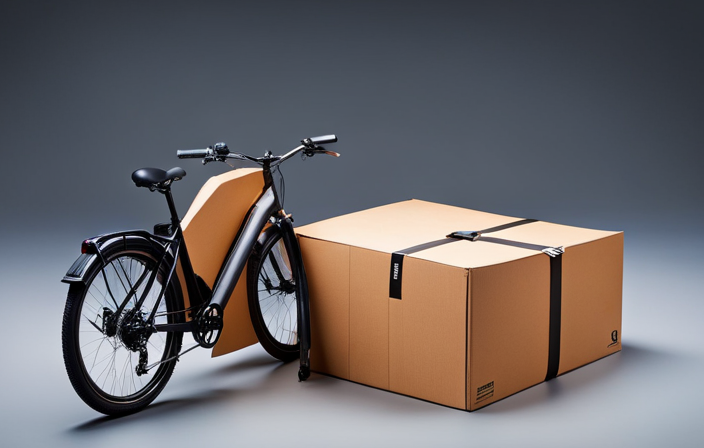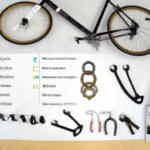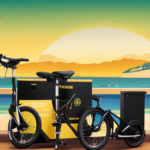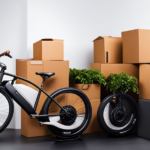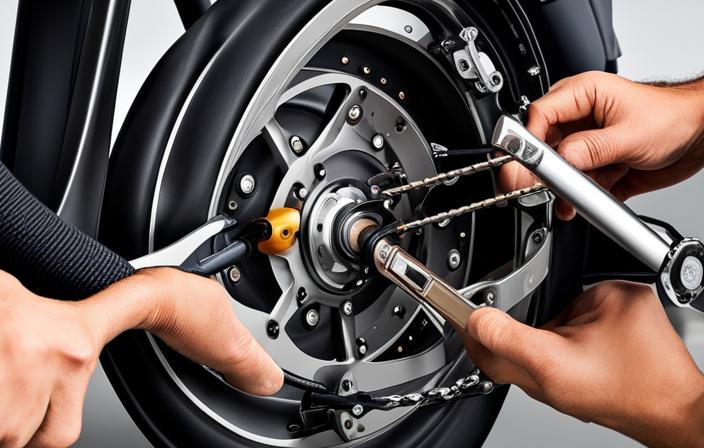Sending an electric bike can seem overwhelming, but with the proper knowledge and preparation, it can be a simple task. In this article, I will walk you through the detailed process of securely packaging and shipping your electric bike.
From assessing the packaging requirements to protecting the frame and components, I will provide you with all the necessary tips and tricks to ensure your electric bike arrives at its new location in perfect condition.
So let’s dive in and get your electric bike on the move!
Key Takeaways
- Assess packaging requirements and gather necessary materials
- Choose a reliable shipping service and select a suitable shipping method
- Properly label the package and track the shipment
- Inspect and test the electric bike upon arrival, and enjoy it while familiarizing with local laws and regulations
Assess the Packaging Requirements for Your Electric Bike
You need to take a moment and consider the packaging requirements for your electric bike because protecting your precious investment is absolutely crucial.
When it comes to shipping an electric bike, you must ensure that it is properly packaged to avoid any damage during transit. Start by checking the shipping restrictions of the carrier you plan to use, as they may have specific guidelines for shipping electric bikes.
Additionally, gather the necessary packaging materials such as a sturdy cardboard box, foam padding, bubble wrap, and zip ties. These materials will help protect your bike from any impacts or vibrations during shipping.
Once you have assessed the packaging requirements and gathered the necessary materials, you can proceed to the next step of packaging your electric bike securely.
Gather the Necessary Packaging Materials
Before you start, make sure to collect all the essential materials needed to securely package your high-tech two-wheeler. Here is a list of packaging materials to assess and gather:
-
Cardboard box: Find a sturdy box that is large enough to fit your electric bike and has additional space for padding.
-
Bubble wrap: Wrap your bike frame, battery, and any other delicate components with bubble wrap to provide cushioning and protect against impact.
-
Packing tape: Use strong packing tape to secure the bubble wrap and seal the box for added protection.
Once you have gathered these packaging materials, you can proceed to choose the most suitable shipping method for your electric bike. It is important to select a reliable and reputable shipping service that specializes in transporting large and fragile items.
Now, let’s move on to the next section and prepare your electric bike for shipping.
Prepare Your Electric Bike for Shipping
To ensure a safe journey for your prized two-wheeler, it’s time to get your high-tech ride ready for its voyage.
Before packing your electric bike, it’s important to assess its dimensions. Measure the length, width, and height of the bike, including any accessories or attachments. This will help you choose the right packaging materials, such as a sturdy cardboard box or a bike-specific shipping case.
Additionally, consider the weight of the bike and choose packaging materials that can handle the load.
Once you have the appropriate materials, it’s time to remove the battery and securely pack it. This step is crucial to prevent any damage during transit.
With the dimensions assessed and packaging materials chosen, it’s time to move on to removing the battery and securely packing it for the journey ahead.
a. Remove the Battery and Securely Pack It
Once you’ve detached the power source, make sure to pack it securely to ensure it stays safe and protected, like a precious gem in a velvet-lined box.
The battery is a crucial component of your electric bike, and it needs to be handled with care during shipping. Start by obtaining a suitable protective packaging specifically designed for batteries. This can include a sturdy case or box with foam inserts to prevent any movement.
Place the battery in the packaging, making sure it is snug and well-supported. Use additional padding if necessary to provide extra cushioning. It’s also important to secure any loose wires or connectors to prevent them from getting damaged.
With the battery packed securely, you can now move on to the next step of protecting the frame and components.
b. Protect the Frame and Components
Now, take a moment to ensure that the frame and components of your valuable two-wheeled companion are adequately protected. To prevent any damage during shipping, it’s crucial to use protective packaging and secure all the bike’s components properly.
Here are four essential steps to follow:
-
Use bubble wrap or foam padding to protect the frame from scratches and impacts.
-
Remove any detachable parts, such as the derailleur or front wheel, and pack them separately in padded boxes.
-
Secure the chain by using a zip tie or rubber band to prevent it from bouncing around and causing damage.
-
Protect the delicate parts, like the brake calipers and derailleur hanger, with additional padding or cardboard.
By taking these precautions, you can ensure that your electric bike arrives at its destination in perfect condition.
Now, let’s move on to the next step: securely fastening the handlebars and pedals.
c. Securely Fasten the Handlebars and Pedals
Make sure to tighten the handlebars and pedals securely to avoid any loose parts during transit. This will give your two-wheeled companion a firm grip for the journey ahead.
When it comes to fastening techniques, start by loosening the stem bolts and aligning the handlebars straight with the front wheel. Then, tighten the bolts back up, ensuring a snug fit without overtightening.
For the pedals, remove them using a pedal wrench or an Allen key. Clean the threads before reinstalling them. Apply some grease to the pedal threads and tighten them securely using the same tool.
Securing accessories like lights, racks, and fenders is also crucial. Use zip ties or bungee cords to keep them in place and prevent any damage.
Now that the handlebars and pedals are securely fastened, let’s move on to deflating the tires, preparing your electric bike for shipping.
d. Deflate the Tires
To securely fasten the handlebars and pedals of your electric bike, you can use zip ties or straps to keep them in place. This will prevent any movement during transit and minimize the risk of damage.
Now, let’s move on to the current subtopic: deflating the tires. It is crucial to deflate the tires before shipping your electric bike to avoid any potential issues during transportation. By deflating the tires, you can prevent them from getting punctured or damaged. Make sure to use a tire gauge to measure the current pressure, and then use a valve tool to release the air.
Additionally, remember to protect your electric bike with packaging materials such as bubble wrap or foam padding to provide extra cushioning and protection.
Once you have deflated the tires and properly packaged your electric bike, you can move on to the next step: labeling your package correctly.
Label Your Package Correctly
Don’t forget to properly label your package for correct shipment.
When shipping an electric bike, it’s important to assess the package dimensions and select the appropriate shipping labels. This ensures that your package is handled correctly and reaches its destination without any issues.
Start by measuring the dimensions of your packaged bike, including its length, width, and height. Then, choose a shipping label that corresponds with the weight and size of your package.
Make sure to clearly write the recipient’s address, your return address, and any necessary shipping instructions on the label. This will help the shipping carrier identify and handle your package with care.
Once you have labeled your package correctly, you can move on to the next step of choosing the right shipping method for your electric bike.
Choose the Right Shipping Method
Selecting the appropriate shipping method for your e-bike can save you time and money. Studies show that choosing the wrong method can result in up to 30% higher shipping costs.
When shipping an electric bike, it is crucial to assess costs and compare shipping options. This ensures a smooth and cost-effective process. Start by considering the weight and dimensions of your e-bike. This will determine which shipping methods are available to you.
For smaller and lighter electric bikes, you may opt for standard ground shipping. This is often more affordable. However, for larger and heavier bikes, freight shipping might be a better choice.
It is important to research and compare shipping prices from different carriers. This way, you can find the most cost-effective option for your specific needs. By carefully assessing costs and comparing shipping options, you can make an informed decision that suits both your budget and your e-bike’s shipping requirements.
Moving on to the next step, consider shipping options and costs…
a. Consider Shipping Options and Costs
Take a moment to explore the various shipping options available to you and carefully consider the costs associated with each, so you can find the perfect solution for getting your e-bike to its destination without breaking the bank. When assessing shipping methods, it’s important to compare shipping costs as they can vary significantly depending on the service provider and the distance your e-bike needs to travel. To help you make an informed decision, here’s a breakdown of shipping options and their estimated costs:
| Shipping Method | Cost (Estimated) |
|---|---|
| Ground Shipping | $50-$150 |
| Air Freight | $200-$500 |
| White Glove | $300-$800 |
| Freight Forward | $400-$1,000 |
By comparing these options, you can determine which one aligns with your budget and timeframe. Once you’ve assessed shipping methods and costs, it’s time to check for any restrictions and regulations that may apply to your e-bike. This ensures a smooth shipping process and avoids any surprises along the way.
b. Check for Restrictions and Regulations
After considering shipping options and costs, it’s important to check for any restrictions and regulations when shipping an electric bike. This step is crucial to ensure a smooth and hassle-free shipping process.
To begin, research local shipping regulations in your area to understand any specific requirements or limitations that may apply. Different regions may have different rules regarding the transportation of electric bikes, such as packaging specifications or permits.
Additionally, if you are planning to ship your electric bike internationally, it is essential to understand the specific shipping requirements of the destination country. This may include customs documentation, import taxes, and any additional permits or certifications that may be needed.
By thoroughly researching and understanding these regulations, you can avoid any potential issues or delays during the shipping process.
Now, let’s move on to the next section, which will cover how to insure your electric bike for added protection.
c. Insure Your Electric Bike for Added Protection
Ensuring the safety of your valuable investment is crucial. It’s important to protect your electric bike with insurance for added peace of mind. When shipping an electric bike, insuring coverage is an important step to consider. Here are four key reasons why you should insure your electric bike before shipping:
-
Protection against damage: Insurance provides coverage in case your electric bike gets damaged during transit. This ensures that you don’t bear the financial burden.
-
Theft coverage: In the unfortunate event of theft, having insurance ensures that you are compensated for the loss of your electric bike.
-
Liability coverage: If your electric bike causes damage to someone else’s property during shipping, insurance can help cover the costs of repairs.
-
Compliance with shipping regulations: Some shipping companies may require insurance coverage for electric bikes to meet their regulations and policies.
Insuring your electric bike provides added protection and peace of mind during the shipping process. Once you have secured the necessary insurance, you can proceed to schedule the pickup or drop-off of your electric bike.
Schedule the Pickup or Drop-Off
Scheduling the pickup or drop-off of your e-bike can be easily done online or over the phone, allowing for a convenient and hassle-free process. When scheduling, you will need to provide information such as the pickup and delivery addresses, the weight and dimensions of your electric bike, and any additional services you may require. It is recommended to compare shipping rates from different carriers to ensure you get the best price for your shipment. Some carriers may offer discounted rates or special services for shipping e-bikes.
Once you have scheduled the pickup or drop-off, you will receive a confirmation with the pickup date and time. This will allow you to plan accordingly and ensure that your e-bike is ready for shipping.
Now that you have scheduled the pickup or drop-off, let’s move on to the next step: tracking your shipment.
Track Your Shipment
Now that you’ve got your e-bike on the move, it’s time to track the progress of your awesome two-wheeled companion! Tracking your shipment allows you to stay informed about its whereabouts and estimated delivery time.
To track the package status, you will need the tracking number provided by the shipping company. Most shipping companies offer online tracking services on their websites or through mobile applications. Simply enter the tracking number, and you’ll be able to see real-time updates on the location of your e-bike.
It’s a good idea to sign up for email or text notifications to receive updates directly. Remember to check for any package tracking tips provided by the shipping company to ensure a smooth tracking experience.
Once you have the shipment details, it’s time to notify the recipient and provide them with the necessary information for a successful delivery.
Notify the Recipient and Provide Shipment Details
Before we get into the exciting details of your e-bike’s delivery, let’s talk about the crucial step of notifying the recipient and providing them with all the necessary shipment information. It’s important to keep the recipient in the loop to ensure a smooth delivery process. Once you have shipped your electric bike, make sure to send a notification to the recipient, informing them about the shipment and providing them with tracking details. This will allow them to stay updated on the progress of their delivery. To make things easier, you can provide a shipment tracking number and a link to the tracking website. This way, the recipient can easily check the status of their package at any time. By keeping the recipient informed, you can ensure a hassle-free delivery experience. Now, let’s move on to the next section and discuss how to reassemble your electric bike upon arrival.
Reassemble Your Electric Bike upon Arrival
Once your eagerly awaited package arrives, you’ll be thrilled to put your new ride together and embark on exhilarating adventures. To ensure a smooth reassembling process, here are some essential steps to follow:
-
Gather the necessary tools: Before starting, make sure you have all the tools required for the reassembly process, such as a set of Allen keys, a wrench, and a screwdriver.
-
Refer to the instruction manual: Carefully read the instruction manual provided with your electric bike. It will guide you through the reassembling process step by step, ensuring you do not miss any crucial details.
-
Troubleshooting tips: In case you encounter any difficulties during the reassembly, refer to the troubleshooting section in the manual. It will provide solutions to common issues that may arise.
Once you have successfully reassembled your electric bike, it’s time to inspect it for any damage before taking it out for a ride.
Inspect Your Electric Bike for any Damage
After eagerly assembling your new ride, take a moment to carefully inspect for any signs of damage.
Start by examining the packaging materials for any signs of mishandling during shipping. Look for dents, tears, or punctures that could indicate potential damage to your electric bike.
Next, inspect the bike frame for any visible cracks or scratches. Check the wheels for any wobbling or misalignment. Ensure that all the electrical components are securely attached and undamaged. Pay special attention to the battery and wiring connections.
If you notice any damage, document it with photos and contact the shipping company immediately.
Remember, it’s crucial to inspect your electric bike thoroughly before proceeding to the next step – test riding to ensure proper functioning.
Test Ride Your Electric Bike to Ensure Proper Functioning
Now, hop on your new ride and experience the exhilaration of testing out your electric bike to ensure it’s in perfect working order. Taking a test ride before shipping your electric bike is crucial as it allows you to identify any potential issues and make necessary adjustments.
Here are four benefits of a test ride:
-
Ensures Proper Functioning: By test riding your electric bike, you can ensure that all components, such as brakes, gears, and motor, are functioning correctly.
-
Identifies Potential Problems: A test ride helps you detect any unusual noises, vibrations, or handling issues that may require further inspection or repair.
-
Ensures Safety: Testing your electric bike allows you to check the responsiveness of the brakes, the stability of the frame, and the overall handling, ensuring a safe riding experience.
-
Adjusts Riding Position: During a test ride, you can adjust the seat height, handlebar position, and other settings to ensure a comfortable and ergonomic riding position.
After completing the test ride and ensuring your electric bike is functioning properly, it’s time to move on to the next step of keeping documentation of the shipment for future reference.
Keep Documentation of the Shipment for Reference
After conducting a thorough test ride of your electric bike, it is essential to keep documentation of the shipment for future reference. This documentation includes important details such as the shipping label. Keeping a copy of the shipping label is crucial in case any issues or discrepancies arise during the shipping process. It serves as proof of shipment and can help resolve any potential problems with the shipping provider.
Additionally, organizing and storing all shipping documentation in a safe and easily accessible place is highly recommended. This ensures that you have all the necessary information at hand if you need to track the shipment or file a claim. By maintaining well-organized shipping documentation, you can have peace of mind knowing that you are prepared for any situation that may arise during the shipping process.
Now, let’s move on to the next important step: leaving feedback for the shipping provider.
Leave Feedback for the Shipping Provider
Once you’ve received your package, don’t forget to leave feedback for the shipping provider to share your experience. Leaving feedback is essential as it not only helps other customers make informed decisions but also gives the shipping provider valuable insights on how to improve their service.
When leaving feedback, be specific about your experience and highlight any areas where the shipping provider excelled or fell short. Discuss aspects such as the packaging quality, delivery time, and overall customer service.
By providing detailed feedback, you contribute to the overall improvement of the shipping provider’s service, helping them identify areas that need attention.
Sharing your shipping experience with others allows them to benefit from your insights and make well-informed decisions when choosing a shipping provider.
Share Your Shipping Experience with Others
After leaving feedback for the shipping provider, it’s important to share your shipping experience with others. As someone who has shipped an electric bike, I understand the importance of finding reliable and efficient shipping solutions. To help fellow electric bike enthusiasts, I would like to share some shipping tips and recommend a few trusted shipping providers.
Here are some key points to consider when shipping your electric bike:
- Proper packaging: Ensure your bike is securely packaged to prevent any damage during transit.
- Insurance coverage: Opt for shipping providers that offer insurance to protect your bike against loss or damage.
- Tracking services: Choose shipping providers that provide real-time tracking so that you can monitor the progress of your shipment.
- Delivery options: Look for shipping providers that offer convenient delivery options such as home delivery or local pick-up.
- Customer reviews: Read reviews and experiences of other electric bike owners to find the most reliable shipping providers.
By following these tips and choosing recommended shipping providers, you can have peace of mind knowing that your electric bike will arrive safely at its new location.
Now, let’s move on to the next section and talk about how to enjoy your electric bike in its new location!
Enjoy Your Electric Bike in its New Location!
Now that you’ve successfully transported your beloved e-bike to its new destination, it’s time to embrace the excitement of exploring your new surroundings with effortless joyrides!
After going through the shipping logistics and possibly dealing with international shipping, it’s a relief to finally have your electric bike with you. Take a moment to inspect your bike for any damages that may have occurred during the shipping process. Check the tires, brakes, and any other important components to ensure everything is in working order.
Once you’ve confirmed that your e-bike is in good condition, it’s time to hit the road! Familiarize yourself with the local laws and regulations regarding electric bikes, as they may differ from your previous location.
Plan out some routes and destinations that you’re eager to explore, and get ready to have a blast riding your e-bike in its new home!
Frequently Asked Questions
Can I ship my electric bike with the battery still attached?
Yes, you can ship your electric bike with the battery still attached, but it is important to comply with shipping regulations. Check with the shipping company for specific guidelines and ensure proper packaging to protect the battery.
How should I protect the electronic components during shipping?
To protect electronic components during shipping, it is crucial to use proper protective packaging and follow the best shipping practices. This ensures that the components remain safe and undamaged throughout the transportation process.
Are there any specific regulations or restrictions for shipping electric bikes?
Oh, the joy of shipping electric bikes! Safety precautions are a must, like disconnecting the battery and padding delicate parts. Best practices include securely packaging the bike in a sturdy box and using plenty of protective materials. Happy shipping!
What steps should I take if my electric bike arrives damaged?
To file a claim for a damaged electric bike, contact the shipping company immediately and provide documentation of the damage. To prevent damage during shipping, ensure the bike is properly packaged and choose a reputable shipping service.
How can I ensure that my electric bike is functioning properly after shipping?
After shipping my electric bike, I ensure its proper functioning by following maintenance tips like securing loose parts, protecting the battery, and checking the brakes. Common issues like damaged components or electrical problems can be troubleshooted with professional assistance.
Conclusion
Well, that’s a wrap! Shipping my electric bike was quite the adventure, but with the right packaging materials and a little preparation, it all worked out smoothly.
Removing the battery and securely packing it, protecting the frame and components, and keeping documentation of the shipment were all key steps in ensuring my bike arrived in one piece.
Don’t forget to leave feedback for the shipping provider and share your experience with others.
Now, it’s time to hit the road and enjoy the journey on my electric bike, the ‘Thunderbolt Express!’
